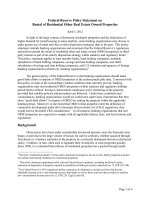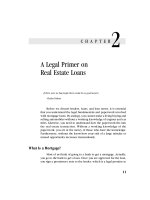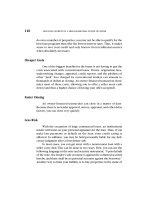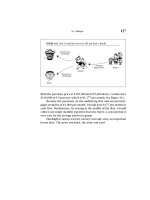Dearborn Financing Secrets of a Millionaire Real Estate Investor 2003_7 pot
Bạn đang xem bản rút gọn của tài liệu. Xem và tải ngay bản đầy đủ của tài liệu tại đây (671.63 KB, 21 trang )
116
FINANCING SECRETS OF A MILLIONAIRE REAL ESTATE INVESTOR
do own a number of properties, you may not be able to qualify for the
best loan programs that offer the lowest interest rates. Thus, it makes
sense to save your credit and only borrow from traditional sources
when absolutely necessary.
Cheaper Costs
One of the biggest benefits for the buyer is not having to pay the
costs associated with conventional loans. Points, origination fees,
underwriting charges, appraisal, credit reports, and the plethora of
other “junk” fees charged by conventional lenders can amount to
thousands of dollars at closing. An owner-financed transaction elimi-
nates most of these costs, allowing you to offer a seller more cash
down
(
and thus a higher chance of having your offer accepted
)
.
Faster Closing
An owner-financed transaction can close in a matter of days.
Because there is no lender approval, survey, appraisal, and other delay
factors, you can close very quickly.
Less Risk
With the exception of large commercial loans, an institutional
lender will insist on your personal signature for the loan. Thus, if you
make late payments or default on the loan, your credit rating is
affected. In addition, you may be held personally liable for any defi-
ciency judgment after a foreclosure sale.
In most cases, you can get away with a nonrecourse loan with a
seller-carry deal. This can be done in two ways. First, you can use the
following language in the note and security instrument: “Upon default
of the note, the lender’s sole recourse is against the collateral secured
hereby, and there shall be no personal recourse against the borrower.”
Another way to limit your liability is to buy properties in the name of
9 / Owner Financing
117
a corporate entity, such as a limited liability company
(
LLC
)
. For more
information about LLCs, visit my Web site at
<
www.legalwiz.com/llc
>
.
Future Discounting
An owner-financed deal may also be an opportunity to profit in
the future. Most owner-financed deals are not the first choice for the
seller, but rather a compromise. Sellers most often want all of their
equity cashed out at closing, yet settle for owner financing because of
a slow housing market or a particular need to sell quickly. The seller’s
desire for cash does not generally diminish in the future, so a seller
may be willing to accept a discount on the balance due on the note.
So, if you are planning to sell the property or refinance the seller-
carry note in the future, always ask the seller if he or she will accept
a discount in the amount that is owed for an early payoff.
Assuming the Existing Loan
Let’s go back to the Sammy Seller/Betty Buyer example. In that
scenario, the seller owned a $100,000 property with an existing mort-
gage lien of $70,000. The seller had $30,000 in equity and was willing
to accept $10,000 of it at closing and the balance in future payments.
The seller also needed $70,000 cash to pay off his existing first mort-
gage lien. Rather than Betty Buyer applying and paying the costs for a
new first mortgage, it would make sense for Betty to assume the exist-
ing $70,000 loan.
Assumable Mortgages
Some mortgages are assumable, that is, they can be taken over by
a new borrower. Many people are familiar with the concept of an
assumable mortgage, but few really understand the details. To
assume
an obligation means to agree to be legally obligated for it. A mortgage
note can be assumed by anyone, that is, anyone can agree to make pay-
ments for someone else.
118
FINANCING SECRETS OF A MILLIONAIRE REAL ESTATE INVESTOR
The concept of an assumable mortgage has to do with the secu-
rity instrument
(
mortgage or deed of trust
)
, not the note. Most secu-
rity instruments contain a “due on sale” or “acceleration” clause. The
due on sale clause allows the lender to call in the balance of the note
if the property is transferred. A security instrument without an accel-
eration clause is referred to as an “assumable” loan. Thus, the expres-
sion “assumable loan” is really a misleading designation; the issue is
not whether the note is assumable, it is whether the mortgage con-
tains a due-on-sale provision. FHA-insured mortgages originated be-
fore December 1989 and VA-guaranteed mortgages originated before
August 1988 contain no due-on-sale provision.
Assumable with Qualification
A mortgage without a due-on-sale clause is known as a “freely-
assumable” loan because the buyer does not need any income or
credit qualification to take over the property. With some loans, a
lender may waive the due-on-sale option. The lender will usually do
so if the buyer submits a credit application to the existing lender.
These types of loans are known as “qualifying assumables.” Assuming
these loans generally require the same credit and qualification as a
new loan, but you avoid the fees associated with a new loan. In addi-
tion, the loan may be amortized for a few years, which means you pay
less interest in the long run.
Buying Subject to the Existing Loan
If you take ownership to a property without paying off or for-
mally assuming the existing loan, you are taking title “subject to” the
existing loan. In most cases, the mortgage or deed of trust securing the
existing loan contains a due-on-sale restriction, allowing the lender to
call the balance owed immediately due and payable. If you intend to
own the property for only a short period of time, the due-on-sale issue
is, at least to you, wholly irrelevant. You will have sold the property
9 / Owner Financing
119
long before the lender discovers the transfer and decides to accelerate
the loan.
If you plan to keep the property for the long run, then the due-
on-sale clause may be an issue because the lender could, in theory,
accelerate the loan within 30 days. At that point, you would have to
either assume the loan or pay it off. If you don’t pay it off, the lender
could initiate foreclosure proceedings and you would lose the house.
You would not be personally liable to the lender because you did not
sign the original note. However, if you promised the former owner to
make the payments, he or she could have legal recourse against you
for defaulting on his or her payments.
Risk versus Reward
Buying a property subject to the existing loan is a risk versus
reward gamble. The reward is that you avoid loan costs, personal lia-
bility for the note, and conserve your cash. You can also take advan-
tage of favorable interest rates because an owner-occupied loan is
likely to have a lower interest rate than if you originated an investor
loan. You can also get away with a lower down payment.
The legal risk was addressed above, but what is the practical risk?
That is, what is the real risk of the lender calling in the loan? Now-
adays, the risk is pretty slim. Lenders began inserting due-on-sale
clauses in their mortgages in the 1970s when interest rates rose dra-
matically. Homebuyers were assuming existing loans rather than bor-
rowing new money from banks because the interest rates on existing
loans were lower. The banks used the due-on-sale clause as a way to
kill their own worst competition. If people had to pay off their loans
when they sold properties, the banks could finance the buyers at the
current dramatically higher interest rates.
So long as the interest rate on the existing loan is within a few
percentage points of market rates, the lender is not likely to accelerate
a performing loan. The reason is simply profit: It costs money in legal
fees, and the lender would rather get paid than have another defaulted
loan on its books.
120
FINANCING SECRETS OF A MILLIONAIRE REAL ESTATE INVESTOR
However, if interest rates did rise dramatically, a lender might
enforce the due-on-sale clause at a later time, forcing you to pay off
the loan. If you plan to hold the property for the long term, you should
consider a backup plan for this contingency, such as having the ability
to refinance or sell the property. If there was enough equity in the
property, you could always bring in a partner to put up the cash or re-
finance the property.
Convincing the Seller
You won’t find too many sellers willing to hand over their prop-
erty without paying off the existing loan, unless the property has no
equity and/or is in foreclosure. Thus, the issue for the seller is: “How
do I know you’ll make the payments?” The seller wants finality; he
wants his loan paid off completely and removed from his credit
report.
Is This Legal?
Many people are under the mistaken impression
that transferring title to a property secured by a
due-on-sale mortgage is illegal. This is because
most lay people confuse civil liability with crimi-
nal liability. To be illegal, you must be in violation
of a criminal law, code, or statute. There is no fed-
eral or state law that makes it a crime to violate a
due-on-sale clause or conceal it from a lender. If
the lender discovers the transfer, it may, at its
option, call the loan due and payable. If it cannot
be paid, the lender has the option of commencing
foreclosure proceedings. You should also disclose
the due-on-sale issue clearly in writing, particu-
larly if you are a real estate agent or are dealing
with parties not represented by an attorney.
9 / Owner Financing
121
Simply tell the seller your intentions: You are going to pay off his
loan within a year or two by selling or refinancing the property. In the
meantime, you will continue making his payments. If this is not good
enough, simply insert a clause into the purchase contract as follows:
Purchaser agrees to satisfy Seller’s loan with ________
_________ bank loan # _________ on or before __________,
20___, and further agrees to make timely monthly payments
required by said lender, including tax and insurance escrows
as they become due.
The payoff date should be at least one year, preferably one, two,
or three. Of course, the seller’s legal recourse is to sue if you don’t per-
form given that he has no recourse against the property. If he is savvy
enough
(
or concerned enough
)
to understand his legal position, offer
him a second mortgage on the property. This mortgage is for a nomi-
nal amount, such as $10, but states that your failure to make payment
on his underlying mortgage places you in default of the second mort-
gage. Thus, if you failed to make payments, he would have the right to
foreclose against the property to get title back.
Another way to make him feel more secure would be to set up a
third-party escrow with a collection company. This company would
collect payments from you each month, send them to the lender and
send a copy to the seller. A more practical way to accomplish the same
task would be to set up a bank account with a direct deposit to the
lender. The bank would send the seller duplicate copies of the bank
statements each month. There are also several automated services on
the Internet that will do it for you, such as
<
www.paytrust.com
>
.
Your own bank may also have direct deposit and other automated
banking services.
A Workaround for Down Payment Requirements
Buying subject to the existing mortgage loan is a nice short-term
strategy to work around lender down payment requirements. For pur-
chase money loans, lending guidelines require a certain down pay-
122
FINANCING SECRETS OF A MILLIONAIRE REAL ESTATE INVESTOR
ment by the borrower. For refinance loans, however, the guidelines
are strictly loan to value.
Example:
Selina Seller has a property worth $100,000 that
she agrees to sell to Bunny Buyer for $80,000. Lending guide-
lines for ABC Savings Bank state that the loan may not exceed
an 80% LTV. So, in theory, Bunny could borrower $80,000,
the entire purchase price. However, ABC’s lending guide-
lines limit the loan to 80% of the purchase price or appraisal,
whichever is less. Thus, Bunny needs to put $16,000 down
(
20% of $80,000
)
, and ABC will lend her $64,000
(
80% of
$80,000
)
. Furthermore, Bunny will probably pay about
$5,000 in costs to get the loan from ABC.
If Selina has a $75,000 existing first mortgage loan,
Bunny could give her $5,000 in cash and buy the property
subject to the existing loan. A year later, Bunny could refi-
nance the existing loan. The refinance guidelines for ABC
Savings Bank are an 80% LTV for investors. Because Bunny
has owned the property for a year, ABC will offer her 80%
of its appraised value, which is $80,000
(
80% × $100,000
)
.
The $80,000 would cover the payoff of the existing $75,000
mortgage, plus the closing costs. So, in the long run, Bunny
has less cash out of pocket. The chances that the lender
would find out about, much less enforce, the due-on-sale
clause on Selina’s loan within 12 months are slim to none.
Installment Land Contract
If a seller is not willing to hand over the deed, you can purchase
using an installment land contract
(
ILC
)
. The
installment land con-
tract
is an agreement by which the buyer makes payments under an
agreement of sale in installment payments. The transaction is also
known by the expressions, “contract for deed,” “bond for deed,” and
“agreement for deed.” The seller holds title as security until the bal-
ance is paid. In many respects, the land contract is identical to a mort-
gage, in that the buyer takes possession of the property, maintains it,
☛
9 / Owner Financing
123
and pays taxes and insurance. However, title remains in the seller’s
name until the balance of the debt is paid.
A land contract usually contains a forfeiture provision, under
which a defaulting buyer may be dealt with similarly to a defaulting
tenant. Though recent court decisions and some state statutes have
refused to enforce this provision, the seller having title makes the
buyer feel psychologically disadvantaged. If you have title to the prop-
erty, the old adage that possession is nine-tenths of the law works
heavily in your favor.
Under a land contract, legal title remains in the seller’s name until
the purchase price is satisfied. The seller has a real property interest,
but holds title essentially as security. The land contract creates an eq-
uitable conversion of the seller’s interest to the buyer when the docu-
ment is signed. The buyer has equitable title and, for all intents and
purposes, is the owner of the property. When the buyer satisfies the
indebtedness, the legal title passes and the buyer’s equitable and legal
title merge. See Figure 9.2.
FIGURE 9.2
Land Contract Transaction
Investor/Seller
1st Mortgage or
Deed of Trust
Buyer Lender
124
FINANCING SECRETS OF A MILLIONAIRE REAL ESTATE INVESTOR
The legal/equitable distinction is difficult for many people to
understand, so here is a more common example. Suppose that you
purchase an automobile from a dealer using a bank loan. The lender
holds title until you pay off the loan. You are the equitable owner; that
is, you have the right to drive the car. The bank holds legal title, but
the bank’s officer cannot drive your car without your permission.
Benefits of the Land Contract
The main problem with transferring title subject to the existing
mortgage is the possibility of the lender finding out about the sale. A
land contract transaction, like a lease, is not likely to come to the
attention of the holder of the underlying mortgage. The anonymity
factor is what makes the installment land contract appealing for all
parties involved. And, even if the lender does discover the transac-
tion, it may not consider a land contract a violation of the due-on-sale
requirements
(
although most court decisions have ruled that a land
contract is a “transfer” that triggers the due-on-sale
)
.
VA Loan Exception
The land contract does not trigger the due-on-sale
clause on VA-guaranteed loans. According to the
VA loan guarantee regulations, a transaction that
does not involve the seller transferring title to the
buyer is not a “sale.” Thus, you can use the land
contract to “assume” VA loans that are not really as-
sumable! Keep in mind that while a land contract
may not trigger the due-on-sale on a VA-guaranteed
loan, it does not give the borrower his VA entitle-
ment back until the underlying VA-guaranteed loan
is paid off.
9 / Owner Financing
125
Problems with the Land Contract
The basic challenge with using a land contract is the uncertainty
of the parties’ legal rights. A few states have specific enumerated rules
for taking back a property in default of a land contract. For example,
Texas law requires a specific notice to the defaulting buyer and a stat-
utory period for the buyer to make up back payments. After that time,
the seller can declare the contract in default and evict the buyer like
a tenant. Illinois, Pennsylvania, North Dakota, and Ohio also have sim-
ilar statutes.
In most states, however, the parties’ rights are not clearly defined.
Some courts treat the transaction as a purchase agreement, while oth-
ers treat it as a mortgage transaction, requiring the seller
(
AKA lender
)
to commence a foreclosure proceeding. Make sure that you have an at-
torney carefully draft the agreement in your favor, depending on
whether you are buying or selling.
Using a Purchase Money Note
As you are now aware, most lenders sell their loans on the sec-
ondary market soon after the loans are made. The secondary market
players, like FNMA, will not buy an individual note from a private indi-
vidual. However, there is an entire market of small, private investors
that do buy mortgage notes one at a time.
Lending regulations are extremely complex and ever-changing,
so I do not recommend you jump into the lending business. However,
when the occasion presents itself, you can act as a lender by creating
a note, then selling it simultaneously at closing to a third party.
When dealing with yield and discount concepts, keep the pro-
cess simple: Find out what note buyers are looking for, then create a
note to fit their criteria. A host of note buyers and a list of their buying
criteria can be found on the Internet at
<
www.notenetwork.com
>
and
<
www.americannote.com
>
. The purchase price for the note will
126
FINANCING SECRETS OF A MILLIONAIRE REAL ESTATE INVESTOR
depend on a number of factors, such as the value of the property, your
creditworthiness, and whether it is rental property. At closing, you
sign a note to the seller that is turned into cash when the note buyer
purchases it from the seller. This may require closing in escrow while
waiting for the funds from the note buyer.
Keep in mind that the note buyer will have fairly stringent loan-
to-value criteria and will want to purchase the note at a discount off
the face amount. For example, if the property is worth $100,000, the
note buyer may require that the maximum loan to value ratio is 90 per-
cent, which means the note will be for $90,000. In addition, the note
buyer may only pay 90 percent of the face amount of the note, which
is $81,000. If the seller is only looking to net $81,000, the transaction
will work for everyone. One of the benefits of using a note to pur-
chase property is that you avoid paying conventional loan costs, such
as underwriting, points, and document preparation. You also need
not worry about being penalized by traditional lending criteria for
buying a property at a discounted price.
Variation: Create Two Notes, Sell One
Another way to skin the proverbial cat is to create two notes
secured by two mortgages on the property. Sell the note and mort-
gage at closing for cash, giving the seller the cash proceeds. Make pay-
ments to the note buyer on the mortgage and to the seller on the
second mortgage.
Another Variation: Sell the Income Stream
Note buyers don’t just buy entire notes, they also buy partials.
Partials
are parts of the income stream, that is, a portion of the total
payments due on the note. For example, a $100,000 note at 9 percent
will pay down about $12,000 in principal in the first ten years. The
total principal and interest payments on the loan over the first ten
years, however, will be over $96,000! Suppose that you found some-
9 / Owner Financing
127
one willing to pay $20,000 for these $96,000 worth of payments
(
a
yield of almost 16 percent
)
. Thus, at closing the seller gets $20,000
plus the remaining 240 payments on the mortgage, the balance of
which will be $88,000 in ten years.
Your sales pitch is that the seller will receive $108,000 for the pur-
chase price, when in fact he or she is asking only $100,000! In reality,
the present value of the remaining 240 payments on the note is much
less. However, the seller may get just what he or she needs—a chunk of
cash now and an income stream for his or her retirement years.
Wraparound Financing
We are in a unique time in history in that real estate prices are
rising, yet interest rates are dropping. At the same time, there is fierce
competition for subprime loans, that is, loans to people with less than
perfect credit and income. Virtually anyone can obtain a home loan,
but interest rates and points charged for these loans are astronomical.
This means that those who can borrow at low interest rates and loan
at higher interest rates are making a bundle! Combine the interest
rate spread and a hot housing market and your ability to make a profit
grows exponentially.
The Basics of Wraparound Financing
In its most basic form, a “wraparound” mortgage, or “wrap,” is
an arrangement wherein you sell a property encumbered with exist-
ing financing by accepting payments in monthly installments rather
than all cash.
Example:
Susie Seller buys a $90,000 house at a 10% dis-
count
(
$81,000
)
. She borrows $81,000 from First Federal
Financial on a favorable 8% 30-year loan. Her principal and
interest payments are roughly $594 per month. She sells the
☛
128
FINANCING SECRETS OF A MILLIONAIRE REAL ESTATE INVESTOR
property to Barney Buyer for $100,000
(
about 10% above
market
)
, taking $10,000 down and carrying the balance of
$90,000 at 11% for 30 years. She does not pay off the under-
lying loan but rather collects payments
(
$952 per month
)
from Barney on a monthly basis and continues to make pay-
ments on the underlying loan. She collects $358 per month
cash flow on the “spread” for 30 years!
The Secret of How Bankers Make Money
Actually, it’s not a secret at all. In fact, bankers
have been doing this for hundreds of years. Bank-
ers make money by borrowing at low interest
rates, then lending at higher interest rates. You
deposit money in a savings account and they pay
you 3 percent interest. They lend the same money
back to you for home loans at 8 percent or more.
The spread between the interest rate they pay and
the interest rate they collect over the life of the
loan is incredibly profitable.
Consider this simple example: You are shop-
ping for rates to refinance your home loan. A lender
quotes you 7 percent interest. On a $100,000 loan,
the monthly payment
(
amortized over 30 years
)
is
about $665 per month. However, at the last minute
(
always happens
)
, someone at the bank decides
that the color of your underwear isn’t right, so your
interest rate changes to 7.25 percent. Your monthly
payment will now be $682. You aren’t terribly
upset because, after all, what’s $17 per month?
What you do not realize is that the additional ¹⁄₄ per-
cent amounts to over $6,000 in interest over the life
of your loan!
9 / Owner Financing
129
This is a basic example of a wraparound deal. As you can see, the
profitability with wraps is based on two simple financial principles:
“borrow low, lend high” and “buy low, sell high.” Susie bought the
property a little below market price and sold it a little above market
price. A new owner-carry loan at a higher interest rate was created
that wrapped around the existing loan.
In a wrap transaction, the buyer gives the seller a promissory
note for substantially all of the purchase price that is secured by a
mortgage or deed of trust. Because the first mortgage is not satisfied
at closing, the seller’s mortgage is a junior lien. At closing of the trans-
action, the buyer has title and the seller has a second wraparound
mortgage that is junior in position to the existing first mortgage. The
wraparound mortgage is essentially the same as a regular mortgage,
but it incorporates the terms of the underlying senior mortgage. The
buyer typically makes payments of principal, interest, taxes, and
insurance to the seller, who then satisfies his or her monthly obliga-
tions on the underlying mortgage for the same items. See Figure 9.3.
In states that use deeds of trust rather than mortgages, the term
“all-inclusive trust deed”
(
AITD
)
is used. The document is slightly dif-
ferent, but the concept is the same.
Wraparound Land Contract
A wrap can also be done with an installment land
contract. You can buy on land contract, then sell
on land contract. Or, you can buy with conven-
tional financing, then sell on land contract. Either
way, the wrap concept means you are collecting
one payment and paying an underlying loan.
130
FINANCING SECRETS OF A MILLIONAIRE REAL ESTATE INVESTOR
Wraparound versus Second Mortgage
By definition, a wraparound is subordinate, or second, to the
existing financing. Technically, it is a second mortgage or lien. How-
ever, let’s contrast the wrap with the traditional method of owner
financing, in which the seller accepts a note and second mortgage.
Consider Sandy Seller who has a house worth $100,000. He has
a mortgage loan balance of $72,000. He has $28,000 in equity. The
interest rate on the $72,000 mortgage note is 7 percent.
Bunny Buyer offers $8,000 cash to Sandy Seller subject to the
existing first mortgage of $72,000. At closing, Bunny also gives Sandy
a $20,000 note at 8 percent interest, secured by a second mortgage
lien on the property. See Figure 9.3.
Now consider the transaction if Sandy Seller counteroffers with a
wraparound scenario, in which he takes $8,000 down and a wrap-
around note and mortgage for $92,000 at 8 percent interest. Notice
FIGURE 9.3
A Second Mortgage Transaction
Sandy Seller
$72,000
1st Mortgage
Bunny Buyer
Lender
$72,000 @ 7%
= $479.02/month
$20,000 @ 8%
= $146.75/month
$20,000
2nd Mortgage
9 / Owner Financing
131
the difference between the two? It is a subtle distinction, but note that
in both cases, Sandy Seller makes 8 percent interest on the $20,000
carryback. However, in the wraparound scenario, Sandy also makes a
1 percent point spread on the $72,000 balance because he has fi-
nanced that portion at 7 percent interest and is charging Bunny Buyer
8 percent interest on the entire owner-carry portion. See Figure 9.4.
The payment on $92,000 at 8 percent interest is approximately
$675 per month. The payment on the first/second mortgage combo is
approximately $625 per month. That’s a $50 per month difference!
Thus, the wraparound payment is immensely more profitable in most
situations.
FIGURE 9.4
A Wraparound Transaction
Sandy Seller
$72,000
1st Mortgage
Bunny Buyer
Lender
$72,000 @ 7%
= $479.02/month
$92,000 @ 8%
= $675.06/month
$92,000
Wrap Mortgage
132
FINANCING SECRETS OF A MILLIONAIRE REAL ESTATE INVESTOR
Mirror Wraparound
A slight variation to the subject-to purchase is the mirror wrap-
around. A mirror wrap is commonly done where the seller has little
or no equity but is not willing to simply hand over a deed to the buyer.
So, for example, if the seller owed $97,000 on a $100,000 house at 7
percent interest amortized over 30 years, the wrap would be for
$97,000 at 7 percent interest. At any given time, the buyer’s payoff
will be exactly the same as the payoff amount on the underlying loan.
In fact, the paperwork on a mirror wrap is often prepared by attach-
ing a copy of the underlying note to the wraparound contract. The
wording is usually something like the following:
Purchaser agrees to pay Seller as the full purchase price
for the Property the sum of $97,000, a sum equal to the bal-
ance of a certain promissory note
(
hereinafter “Note”
)
executed by the Sellers on September 23, 2002, to ABC
Mortgage Company, a copy of which is annexed hereto as
exhibit “A,” the terms of which are incorporated herein.
Beginning on March 1, 2003, and continuing on the 1st day
Loan Term Differential Means More Profit!
An additional point worth noting here is that the
existing $72,000 loan was figured at $479.02 per
month based on the assumption that the loan was
originated at $70,000. In other words, the original
loan balance may have been more, meaning, of
course, that the monthly payment may be more.
However, if the existing first mortgage loan was
paid for 8 years, the remaining balance is just 22
years. If the wraparound loan is amortized over 30
years, the seller has a very bright future at the end!
9 / Owner Financing
133
of each month thereafter, the buyer shall make monthly pay-
ments to the seller for principal and interest that mirror the
payments due each month on said Note.
Wraparound Mortgage versus Land Contract
You may be wondering what the difference is between a wrap-
around mortgage and a land contract. As far as the payments go, a
wraparound is a concept that refers to collecting a payment while con-
tinuing to make payments on underlying financing. A traditional wrap-
around mortgage involves the seller transferring title to the buyer,
leaving the existing financing in place, and taking a note with an all-
inclusive payment for the purchase price secured by a second mort-
gage. In a trust deed state, the lien would be an all-inclusive trust deed,
or AITD.
With a land contract wraparound, the title remains in the seller’s
name, and the seller and buyer execute a contract under which the
buyer makes all-inclusive payments to the seller, who in turn makes
payments on the underlying mortgage note. The numbers are the same
in all of these transactions—the difference lies in the way the transac-
tion is collateralized.
Key Points
•
Owner financing is one of the most powerful ways to borrow
money.
•
The land contract is an excellent way to finance an owner-
carry sale.
•
Create purchase money notes, then sell the notes for cash.
•
The wraparound can increase your monthly cash flow.
CHAPTER
10
Epilogue
Hindsight is always twenty-twenty.
—Billy Wilder, Film Director
Recall Chapter 1, where I told a story about a deal that went bad
and cost me my $1,000 in earnest money. I had just come from a real
estate conference where I heard a speaker give a brief presentation on
financing. I took a “nugget” of information and ran with it—a little
knowledge can be a dangerous thing!
Now that you have completed this book, you can help me work
through what I should have done. I’ll round the numbers off to sim-
plify the concepts.
The property was worth $160,000 or so, and the seller was ask-
ing $160,000. The property was listed with a real estate broker. After
some lengthy discussions with the seller and his broker, I discovered
that the seller had a first mortgage with a balance of about $125,000.
His loan was at 9 percent interest, which is about $1,000 per month
in principal and interest payments. The seller’s primary motivation
was getting rid of the house and the monthly obligations.
136
FINANCING SECRETS OF A MILLIONAIRE REAL ESTATE INVESTOR
I offered the seller the following deal:
•
$140,000 purchase price
•
Subject to existing first mortgage of $125,000
•
Promissory note for $15,000 secured by a second mortgage on
the property; no payments on the note, simple interest pay-
ments at 5 percent interest
(
$62.50 per month
)
, balloon pay-
ment due in 5 years
The only issue remaining was how to pay the real estate agent. His
commission was supposed to be 7 percent of the sales price, which
was $10,500. I negotiated his fee down to $6,000, which would be
paid by me at closing, which was 45 days away.
My intention was to find a buyer within the 45 days that could
buy it from me in a double closing
(
see Chapter 5
)
. I offered the prop-
erty for sale under the following terms:
•
$155,000 purchase
•
$15,000 cash, subject to existing first mortgage loan of 9 per-
cent and second owner-carry mortgage loan at 5 percent
Having read this book, it is easy to see a good deal—a buyer could
put down just $15,000 and take title to the property subject to two
existing loans with a blended interest rate of about 8 percent. Because
the deal was subject to existing mortgage loans, there were no loan
costs, points, or other lender fees. I would use the $15,000 to pay the
real estate agent
(
$6,000
)
and pocket the rest
(
$9,000
)
.
I placed an ad in the paper: “No Bank Qualifying—Take Over Pay-
ments.” The phone rang off the hook. But, 150 phone calls and 45 days
later, I didn’t have a buyer. The problem was: The idea was so foreign
to every person who called that I couldn’t get anyone to do the deal!
In retrospect, this was a perfect candidate for
(
you guessed it
)
a
wraparound transaction. With a blended interest rate of about 8 per-
cent, I could have easily sold the property at 9.5 percent interest.









